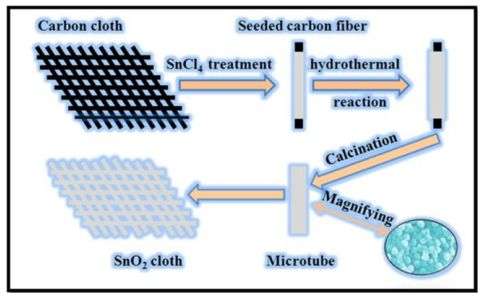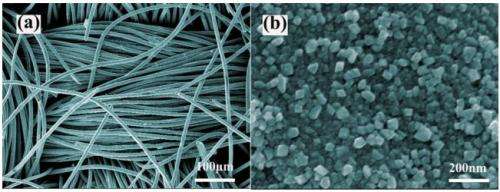July 4, 2013 report
Researchers create flexible tin dioxide cloth self-powered photo detector

(Phys.org) —A team of researchers at China's Wuhan National Laboratory for Optoelectronics has succeeded in creating a bendable tin dioxide cloth material that works as a photo detector complete with its own power source. In their paper published in the newly created peer-reviewed journal Nanoscale, the team describes how they made the cloth by growing tin dioxide nanoparticles on a carbon cloth template.
Electronics that can be integrated with bendable materials has become a major focus of research groups around the world in recent years due to the belief that products made from such efforts would be highly valued by customers. Smart phones that could be folded and put into a pocket is one example, clothes worn on the body with solar cells built into them is another—possibly doing away with the need for batteries. In this new effort the team in China has created a bendable cloth material that they've used to build a working self-powered photo detector.
To make the photo detector and its power source, the team grew tin dioxide nanoparticles on a template of carbon cloth. That resulted in hollow micro-tubes of tin dioxide being interwoven with the carbon cloth material. Tin dioxide was used because it is a semi-conductor that is especially receptive to ultraviolet light and is also useful as a battery source. The result was a flexible tin dioxide photo detector and a flexible tin dioxide lithium ion battery to power the photo detector.
The researchers report that their cloth device is lightweight, small and is highly flexible. Bending it over itself, they add, did not degrade performance. The material can also be cut to size and its performance, they contend, is on a par with conventional devices. They suggest their material could be used as a sensor detection system for large areas with wireless capabilities. They next plan to investigate ways to make similar devices on a smaller scale.

One issue not addressed in the paper is durability of the material—while the team notes that the material they created was capable of lasting through many voltage cycles, they don't make mention of the sticky problem of how it might endure when exposed to environmental conditions such as humidity, sweat, heat, cold, etc.
More information: SnO2-Microtubes-Assembled Cloth for Fully-Flexible Self-Powered Photodetector Nanosystems, Nanoscale, 2013, Accepted Manuscript, DOI: 10.1039/C3NR02300A
Abstract
Integrating an energy conversion or storage device with photodetectors into a self-powered system provides a promising way for future devices aiming at reduced size, light weight and high flexibility. We reported here the fabrication of a fully flexible self-powered photodetector nanosystem by integrating a flexible SnO2-cloth-based ultraviolet photodetector with a flexible SnO2-cloth-based lithium-ion battery. The flexible SnO2-cloth-based ultraviolet photodetectors showed fast response to ultraviolet light with excellent flexibility and stability. Using SnO2-on-carbon-cloth as the binder-free anode electrode and commercial LiCoO2/Al foil as cathode, flexible full lithium-ion battery was first assembled, exhibiting a reversible capacity of 550 mAh g-1 even after 60 cycles at a current density of 200 mA g-1 in a potential window of 2-3.8 V. When integrated with and driven by the flexible full battery, the fully flexible self-powered photodetector nanosystems exhibit comparable performance with the external energy instrument powered device. Such an integrated nanosystem could serve as a detecting system in large wireless areas such as environmental sensing and biosensing.
via Chemistry World
Journal information: Nanoscale
© 2013 Phys.org



















